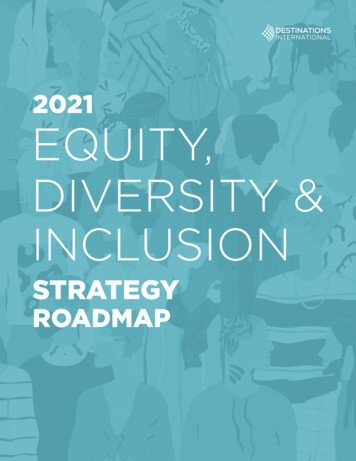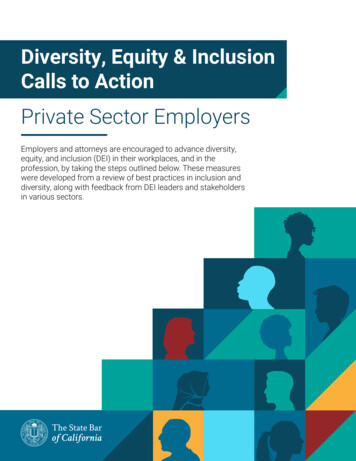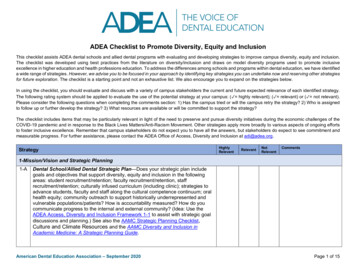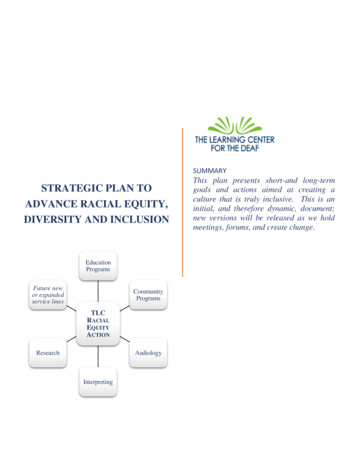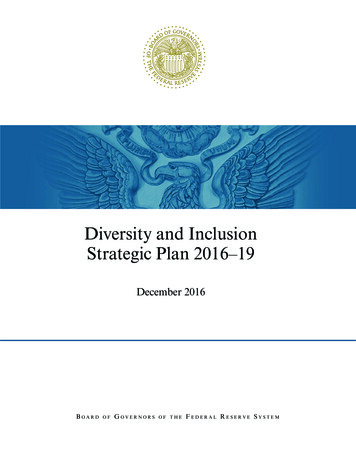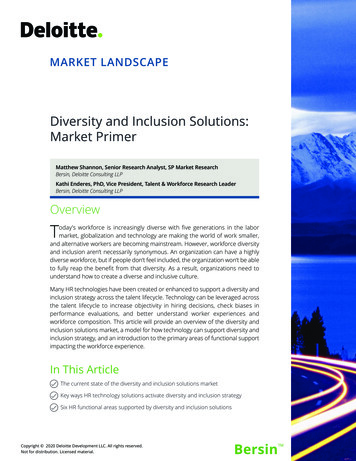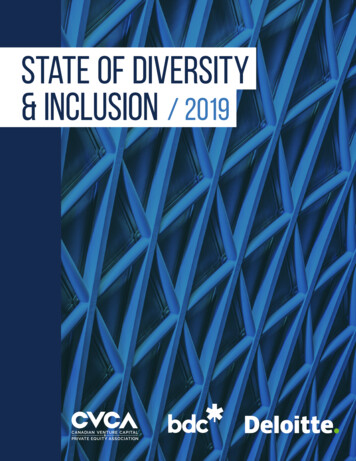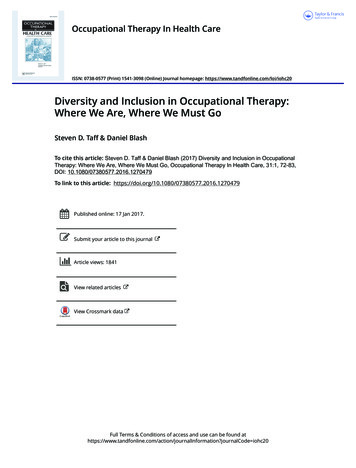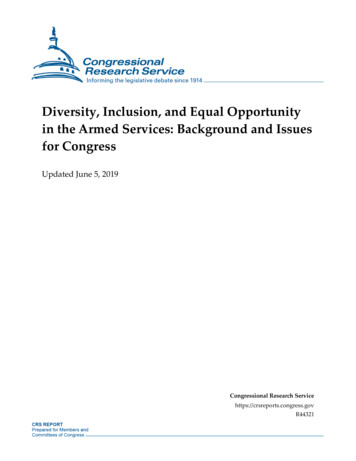
Transcription
Diversity, Inclusion, and Equal Opportunityin the Armed Services: Background and Issuesfor CongressUpdated June 5, 2019Congressional Research Servicehttps://crsreports.congress.govR44321
SUMMARYDiversity, Inclusion, and Equal Opportunity inthe Armed Services: Background and Issues forCongressR44321June 5, 2019Kristy N. KamarckSpecialist in MilitaryManpowerUnder Article 1, Section 8 of the U.S. Constitution, Congress has the authority to raise andsupport armies; provide and maintain a navy; and provide for organizing, disciplining, andregulating them. Congress has used this authority to establish criteria and standards forindividuals to be recruited, to advance through promotion, and to be separated or retired frommilitary service. Throughout the history of the armed services, Congress has established some of these criteria based ondemographic characteristics such as race, sex, and sexual orientation. In the past few decades there have been rapid changesto certain laws and policies regarding diversity, inclusion, and equal opportunity – in particular towards women serving incombat arms occupational specialties, and the inclusion of lesbian, gay, bisexual, and transgender (LGBT) individuals. Someof these changes remain contentious and face continuing legal challenges.Military manpower requirements derive from the National Military Strategy and are determined by the military servicesbased on the workload and competencies required to deliver essential capabilities. Filling these capability needs, from combatmedics to drone operators, often requires a wide range of backgrounds, skills and knowledge. To meet their recruitingmission, the military services draw from a demographically diverse pool of U.S. youth. Some have argued that militarypolicies and programs that support diversity, inclusion, and equal opportunity can enhance the services’ ability to attract,recruit and retain top talent. Other advocates for a diverse force believe that it is in the best interest of the military to recruitand retain a military force that is representative of the nation as a “broadly representative military force is more likely touphold national values and to be loyal to the government—and country—that raised it.” They contend that in order to reflectthe nation it serves, the military should strive for diversity that reflects the demographics of the entire country.Some contend that a military that is representative of the nation should also reflect its social and cultural norms. Suchobservers argue that popular will for social change should be the driving or limiting factor for DOD policies. Others opposethe expansion of certain diversity and equal opportunity initiatives due to concerns about how these initiatives might beimplemented. For example, some contend that diversity initiatives could harm the military’s merit-based system, leading toaccessions and promotions that put demographic targets ahead of performance standards. Others express concern that theinclusion of some demographic groups is antithetical to military culture and could affect unit cohesion, morale, and readiness.When addressing equal opportunity within the Armed Forces, some further note that the military has a unique mission thatrequires the exclusion of some individuals based on, for example, age, physical fitness level, education attainment, or othercharacteristics.Congressional Research Service
Diversity, Inclusion, and Equal Opportunity in the Armed ServicesContentsOverview . 1Why Do Organizations Value Diversity? . 2Diversity and Cohesion . 2Diversity and Effectiveness . 4Diversity Management . 4Diversity and the Civil-Military Relationship . 5Diversity and Social Equality. 5How Does DOD Define Diversity, Inclusion, and Equal Opportunity? . 6Diversity and Inclusion Policy . 6Military Equal Opportunity Policy . 7How Does DOD Manage Diversity and Equal Opportunity? . 9Office for Diversity, Equity, and Inclusion (ODEI) . 9Defense Equal Opportunity Management Institute (DEOMI) . 10Military Departments . 11How Have the Definition and Treatment of Protected Classes Evolved in the ArmedForces? . 11Racial/Ethnic Inclusion: Background and Force Profile . 12The Civil War to World War II, Racial Segregation. 12Desegregation in the Truman Era . 13Civil Rights Movement and Anti-Discrimination Policies . 15The Vietnam War and Efforts to Improve Race Relations . 17Is the Racial/Ethnic Profile of the Military Representative of the Nation? . 19Inclusion of Women: Background and Force Profile . 22Women’s Participation in World War I and World War II . 23Post-WWII and the Women’s Armed Services Integration Act . 24Equal Rights Movement and an All-Volunteer Force . 25The 1990s: Increasing Roles for Women . 27Recent Changes to Women’s Assignment Policies . 29Is the Gender Mix in the Military Representative of the Nation? . 29Lesbian, Gay, Bisexual, and Transgender (LGBT) Inclusion: Background and ForceProfile. 33Advocacy and DOD Policy Formation in the 1970s and 1980s . 34The Evolution of Don’t Ask Don’t Tell . 35Repeal of Don’t Ask Don’t Tell (DADT) . 37Post-DADT Integration . 38Transgender Service Policies . 39Religious Inclusion: Background and Force Profile . 44Is Religious Diversity in the Military Representative of the Nation? . 46Military Diversity and Equal Opportunity Issues for Congress . 47Diversity in Leadership . 47Diversity and Inclusion at the Service Academies . 49Management of Harassment and Discrimination Claims . 51Inclusion of Transgender Servicemembers . 53Religious Discrimination and Accommodation . 56Other Aspects of Diversity . 57Congressional Research Service
Diversity, Inclusion, and Equal Opportunity in the Armed ServicesAre Diversity and Equal Opportunity Initiatives Needed in the Military? . 59FiguresFigure 1. DOD Active Duty Racial and Ethnic Representation . 20Figure 2. Women Serving on Active Duty as a Percentage of Total Active Duty Force . 27Figure 3. Female Representation in the Active Component . 31Figure 4. Women in Combat Policy Changes and Female Propensity for Military Service. 32Figure 5. Non-prior Service Applicants for Active Component Enlistment by Gender andRace/Ethnicity . 33Figure 6. Religious Diversity in the Active Duty Force . 47Figure 7. Representation Ratios for Non-prior Service Enlisted Accessions by State . 57Figure 8. Active Component Enlisted Accessions by Median Household Income . 58TablesTable 1. Diversity Goals for DOD and the Federal Workforce . 6Table 2. Equal Opportunity Definitions in DOD Policy. 9Table 3. Key Factors Measured in DEOCS . 10Table 4. Selected Legislation for Command Climate Surveys . 11Table 5. Military Fatal Casualties as a Result of the Vietnam War . 18Table 6. Race and Ethnic Representation in the Active Component and U.S. Population . 21Table 7. Racial/Ethnic Representation Among Post-secondary Degree Holders . 21Table 8. 1992 Presidential Commission on Women in Combat . 28Table 9. Female Representation in the Active Duty Armed Forces . 31Table 10. Timeline for DOD Transgender Policy Changes . 44Table 11. Military Department Policy Regarding Religious Accommodationand Expression . 46Table 12. Female Enrollment at Service Academies . 49Table 13. Service Academy and U.S. Undergraduate Enrollment by Race/Ethnicity . 49Table 14. Estimated Gender Discrimination and Sexual Harassment at Service Academies . 50ContactsAuthor Information. 60Congressional Research Service
Diversity, Inclusion, and Equal Opportunity in the Armed ServicesOverviewUnder Article 1, Section 8 of the U.S. Constitution, Congress has the authority to raise andsupport armies; to provide and maintain a navy; and to provide for organizing, disciplining, andregulating them. In the past, Congress has used this authority to establish criteria and standardsfor recruiting individuals into the military, promoting them, and separating or retiring them frommilitary service. In many cases, Congress has delegated the authority to develop these criteria andstandards to the Secretaries of Defense and the Military Departments. However, throughout thehistory of the armed services, Congress has passed legislation either limiting or expandingrequirements for military service based on demographic characteristics such as race, sex, andsexual orientation. In the past decade, there have been rapid changes to laws and policiesgoverning the integration of certain demographic groups in the Armed Forces. Since 2009, thesechanges have allowed individuals who are gay to serve openly1 and recognized their same-sexspouses as dependents2, opened submarine billets and combat assignments to women3, and havemodified policies relating to the service of transgender troops.4 While all career fields are open towomen, Congress has not passed legislation that would allow or require draft registration forwomen.5Over the past decade, there have also been a number of efforts by Congress and theAdministration to assess diversity, equal opportunity, and inclusion across the federal workforce.In the Duncan Hunter National Defense Authorization Act for Fiscal Year 2009 (P.L. 110-417),Congress mandated the creation of a Military Leadership Diversity Commission (MLDC) taskedwith conducting “a comprehensive evaluation and assessment of policies that provideopportunities for the promotion and advancement of minority members of the Armed Forces,including minority members who are senior officers.”6 The commission’s final report, FromRepresentation to Inclusion: Diversity Leadership in the 21st-Century Military, noted that whilegreat strides had been made in developing a diverse force, women and racial and ethnic minoritiesare still underrepresented in top leadership positions. In May 2011, the commission’s report wasreleased, and in August 2011, then-President Barack Obama issued an Executive Order (EO13583) calling for a coordinated government-wide initiative to promote diversity and inclusion inthe federal workforce. In Section 528 of the National Defense Authorization Act for Fiscal Year2016 (P.L. 114-92), Congress reaffirmed a commitment to maintaining a diverse military stating:Diversity contributes to the strength of the Armed Forces. It is the sense of Congress thatthe United States should—(1) continue to recognize and promote diversity in the Armed1P.L. 111-321.Secretary of Defense, Extending Benefits to Same-Sex Domestic Partners of Military Members, Memorandum forSecretaries of the Military Departments Acting Under Secretary of Defense for Personnel and Readiness, February 11,2013.3 Department of Defense, “Secretary of Defense Remarks on the Women-in-Service Review,” December 3, 2015.4 Cronk, Teri Moon, “Transgender Service Members Can Now Serve Openly, Carter Announces,” DOD News, June30, 2016.5 For a separate discussion of the selective service see CRS Report R44452, The Selective Service System and DraftRegistration: Issues for Congress.6 The commission’s reference to minorities includes racial/ethnic minorities and women (although not a minority in thegeneral population, women make up a significantly smaller percentage of the total Armed Forces.) The commission didnot address issues related to the service of openly gay men and women as that topic was being addressed by the DODComprehensive Review Working Group.2Congressional Research Service1
Diversity, Inclusion, and Equal Opportunity in the Armed ServicesForces; and (2) honor those from all diverse backgrounds and religious traditions who havemade sacrifices in serving the United States through the Armed Forces.This report is intended to support congressional oversight of DOD’s diversity, inclusion, andequal opportunity programs, policies, and management for uniformed personnel.7 The reportstarts by giving an overview of recent research on diversity and organizational management todemonstrate why organizations value diversity and what the findings on diversity suggest in amilitary context. The next sections outline DOD’s military personnel policies, processes andorganizational structure for managing diversity, inclusion, and equal opportunity. Following that,the report examines how the concept of diversity and inclusion has evolved throughout the historyof the Armed Forces and provides a snapshot of the current demographic composition of themilitary relative to the U.S. civilian population. Finally, the report addresses some of the currentlegislative and policy issues related to diversity in the Armed Forces.Why Do Organizations Value Diversity?Diversity is often defined as the variation of traits within groups of two or more people and mayinclude both traits that are visible (e.g., sex, age, race) and invisible (e.g., knowledge, culture,values). An internet search on “diversity initiatives in the workplace,” produces more than onemillion results. Given the emphasis placed on diversity by modern organizations it is important tounderstand why workforce diversity is valued and what that can mean in the context of militarypersonnel management.Many argue that diversity is a core value of an egalitarian and multicultural society andorganizations should seek diversity regardless of its relationship with performance metrics.8 Froma human resource perspective, diversity is typically studied with regard to its impact on groupdynamics and other factors that contribute to organizational performance. Two key factors thathave been studied in both the civilian and military context are cohesion: commitment to other members of the group and the group’s sharedobjectives; andeffectiveness: the ability of the group to efficiently meet its objectives.Studies on the impact of diversity on these factors have had mixed findings, leading some toargue that diversity is beneficial to organizational success, and others to suggest that it might beharmful.Diversity and CohesionMilitary cohesion is often considered to be a positive group attribute that contributes to the team’sability to cooperate and perform at high levels under stressful conditions. There are varyingdefinitions of cohesion. In the military context, the 1992 Presidential Commission on theAssignment of Women in the Armed Forces defined it asthe relationship that develops in a unit or group where (1) members share common valuesand experiences; (2) individuals in the groups conform to group norms and behavior inorder to ensure group survival and goals; (3) members lose their personal identity in favor7This report does not provide extensive information on policies and programs for DOD civilian personnel, or for U.S.Coast Guard uniformed personnel who are operating under the Department of Homeland Security.8 O'Brien, Lauren T. and Patricia N. Gilbert, “Ideology: An Invisible yet Potent Dimension of Diversity,” in The OxfordHandbook of Diversity and Work, ed. Quinetta M. Roberson (New York, NY: Oxford University Press, 2013), p. 135.Congressional Research Service2
Diversity, Inclusion, and Equal Opportunity in the Armed Servicesof a group identity; (4) members focus on group activities and goals; (5) unit membersbecome totally dependent upon each other for the completion of their mission and survival;and (6) group members meet all standards of performance and behavior in order not tothreaten group survival.9Some studies have found that higher overall levels of cohesion are associated with individualbenefits of increased job satisfaction, retention, and better discipline outcomes.10 Meta-analysis ofgroup performance and cohesiveness has suggested that, on average, cohesive groups performbetter than non-cohesive groups.11 Others note that where observed causal relationships betweencohesion and group performance exist, it is more often the performance of the group that affectsthe level of cohesiveness (i.e., unit success leads to a more cohesive unit) rather than thereverse.12Recent studies of group cohesion focus on two ways that group cohesion develops.13 Social cohesion is the extent to which group members like each other, prefer tospend their social time together, enjoy each other’s company, and feelemotionally close to one another.Task cohesion is the shared commitment among members to achieving a goal thatrequires the collective efforts of a group.Some behavioral research has found that interpersonal relationships that lead to social cohesionare established more readily between individuals with similar backgrounds, experiences anddemographic characteristics.14 In addition, some studies have found that teams with high levels ofsocial cohesion have less conflict15 and stronger support networks, which may help individuals tobetter cope with stress.16 In the military context, those who argue for more homogenous units17argue that these units develop stronger interpersonal bonds that provide important psychologicalbenefits and bolster unit resiliency when operating in highly stressful and austere environments.18They also argue that “out-group” members—those with different characteristics than the majority9Presidential Commission on the Assignment of Women in the Armed Forces, Report to the President, November, 15,1992, p. C-80.10 Oliver, Laurel W. et al., “A Quantitative Integration of the Military Cohesion Literature,” Military Psychology, vol.11, no. 1 (1999). Oliver et al. (1999).11 Evans, Charles R. and Kenneth L. Dion, “Group Cohesion and Performance,” Small Group Research, vol. 43, no. 6(December 2012).12 Rostker, Bernard D. et al., Sexual Orientation and U.S. Military Personnel Policy; An Update of RAND’s 1993Study, RAND Corporation, Santa Monica, CA, 2010, p. 141.13The distinction between these two lines of cohesion has become increasingly common in academic literature over thepast two decades. These definitions are derived from definitions in Rostker, Bernard D. et al., Sexual Orientation andU.S. Military Personnel Policy; An Update of RAND’s 1993 Study, RAND Corporation, Santa Monica, CA, 2010, p.139.14 Reagans, Ray, “Demographic Diversity as Network Connections: Homophily and the Diversity-PerformanceDebate” in The Oxford Handbook of Diversity and Work, ed. Quinetta M. Roberson (New York, NY: OxfordUniversity Press, 2012), p. 181.15 Ibid. p. 181.16 Ahronson, Arni and James E. Cameron, “The Nature and Consequences of Group Cohesion in a Military Sample,”Military Psychology, vol. 19, no. 1 (2007), pp. 9-25.17 Over time, this argument has been used to advocate against integrated military units with regard to race, gender, andsexual orientation.18 See for example, U.S. Department of Veterans Affairs, Office of Research and Development, “Unit Cohesion Couldbe Key to PTSD Resiliency,” September 12, 2014, at mer201427.cfm.Congressional Research Service3
Diversity, Inclusion, and Equal Opportunity in the Armed Servicesof others in the groups—may experience negative individual psychological effects as a result ofpoor social integration.Other studies have found shared experiences can contribute to task cohesion and that this type ofcohesion is a stronger predictor of group performance than social cohesion.19 This leads some toargue that the “sameness” of individuals in a military unit is less important than the sharedexperiences of the unit. In this regard, some argue that military units that operate in an integratedmanner can build task cohesion through integrated training.20Diversity and EffectivenessSome studies on the effectiveness of small groups have found that the presence of diversity (inparticular racial and gender diversity) is associated with better creative problem solving,innovation, and improved decisionmaking.21 These positive outcomes are sometimes attributed tothe broader range of perspectives, knowledge, and experience available in diverse groups relativeto homogenous groups. Those who argue for diversity initiatives in the military argue that a morediverse force has the potential to be more efficient and flexible, and able to meet a broader set ofchallenges.Other studies have found that within diverse groups individuals with demographically similarcharacteristics tend to build strong in-group relationships to the detriment of the larger unit.22 Thepresence of demographic in-groups has been found in some circumstances to negatively affectgroup productivity, particularly if active fault lines or biases exist between subgroups.23 Thosewho argue against the integration of certain subgroups suggest that there are pervasive culturalbiases that can contribute to interpersonal friction within military units and distract from theunit’s ability to perform under stress.Diversity ManagementWhile the direction and magnitude of the effects of diversity on group performance remaindebatable, there is a wide body of literature that links the performance of diverse groups toleadership and management.24 Among human resource professionals in the public and privatesectors, the focus in workforce management has shifted from diversity acquisition (e.g.,affirmative action and hiring quotas) to diversity management. Under the previous philosophy,employers set targets for accessions based on race, sex, or other attributes in order to bolster19Mullen and Copper (1994) and Beat et al.In the past, training pipelines and in some instances units were segregated by race and gender. As of 2015 the MarineCorps has separated men and women for portions of basic training.21 See review of the literature in, Richard, Orlando C. and Carliss D. Miller, “Considering Diversity as a Source ofCompetitive Advantage in Organizations.” in The Oxford Handbook of Diversity and Work, ed. Quinetta M. Roberson(New York, NY: Oxford University Press, 2012), p. 240.22See review of the literature in, Jehn, Karen A. and Lindred L. Greer, “Diversity as Disagreement: The Role of GroupConflict” in The Oxford Handbook of Diversity and Work, ed. Quinetta M. Roberson (New York, NY: OxfordUniversity Press, 2012), p. 181.23 Thatcher, Sherry M., “Moving Beyond a Categorical Approach to Diversity: The Role of Demographic Faultlines,”in The Oxford Handbook of Diversity and Work, ed. Quinetta M. Roberson (New York, NY: Oxford University Press,2012), p. 59.24 Ferguson, Melissa J. and Shanette C. Porter, “An Examination of Categorization Processes in Organizations: TheRoot of Intergroup Bias and a Route to Prejudice Reduction,” in The Oxford Handbook of Diversity and Work, ed.Quinetta M. Roberson (New York, NY: Oxford University Press, 2013), p. 98.20Congressional Research Service4
Diversity, Inclusion, and Equal Opportunity in the Armed Serviceshistorically underrepresented groups. More recent diversity management philosophies focus onbuilding organizational culture and policies to better attract a diverse workforce and toaccommodate career development for employees with different backgrounds.Diversity and the Civil-Military RelationshipGiven the U.S. military’s unique role in society there are additional reasons that diversity couldbe of value within the defense establishment. In the military, the value of diversity is sometimesdiscussed as a facet of the civil-military (civ-mil) relationship. Some explain this relationship as atrinity of civilian leadership, civil society, and military servicemembers.25 Civilian leadershipultimately decides how to resource and employ the military. These decisionmakers are influencedby civilian society (their constituents). In an all-volunteer force, recruits are drawn from civilsociety. Some portion of civil society serves, has served, or is directly affected by those whoserve. The strength of the relationship between civil society and those who serve has been tied tothe willingness of a democratic populous to hold civilian leaders accountable for decisions toenter and engage in conflict and to expend national resources to sustain a military force.26On the other end, civilian leaders oversee the implementation of national security policies andhold military leaders accountable. One concern many have is that a cadre of military leaders wholack meaningful connections with civil society could question the legitimacy of civilian authorityin military matters.27 In the context of such concern, advocates for a diverse force believe thatsuch a force is in the best interest of society because “a broadly representative military force ismore likely to uphold national values and to be loyal to the government—and country—thatraised it.”28Diversity and Social EqualityAnother argument for demographic representation is based in social equality. From thisperspective, many believe that the risks of military service should be shared equally among allqualified citizens, and not disproportionately the burden of certain geographic, demographic, orsocioeconomic groups. Others note that military service confers various benefits, opportunities,and status within society (e.g., veterans’ preference in federal or state hiring29, education benefits,specialized training). As a result, some social equality advocates argue that all qualifiedindividuals should have equal opportunities to participate, earn the benefits, and advance withinthe military.Evans, Col. Charles M., “Impact of Diversity on the Civil-Military Relationship,” School of Advanced MilitaryStudies, United States Army Command and General Staff College., May 2013, p. 11.26 Owens, Mackubin Thomas, “What Military Officers Need to Know About Civil-Military Relations,” Naval WarCollege Review, vol. 65, no. 2 (Spring 2012).27 Ibid., p. 80.28 Armor, David J., "Race and Gender in the U.S. Military," Armed Forces & Society, vol. 23, no. 1 (Fall 1996), pp. 727.29 Veterans account for about 10% of the U.S.
equal opportunity programs, policies, and management for uniformed personnel.7 The report starts by giving an overview of recent research on diversity and organizational management to demonstrate why organizations value diversity and what the findings on diversity suggest in a military context.


